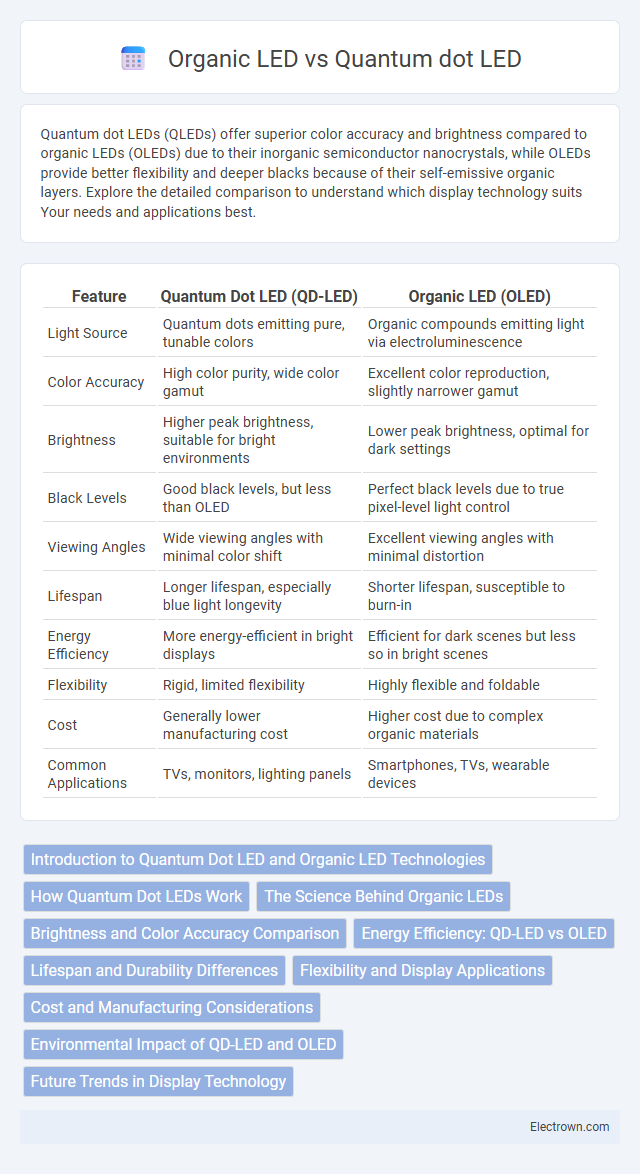Quantum dot LEDs (QLEDs) offer superior color accuracy and brightness compared to organic LEDs (OLEDs) due to their inorganic semiconductor nanocrystals, while OLEDs provide better flexibility and deeper blacks because of their self-emissive organic layers. Explore the detailed comparison to understand which display technology suits Your needs and applications best.
Table of Comparison
| Feature | Quantum Dot LED (QD-LED) | Organic LED (OLED) |
|---|---|---|
| Light Source | Quantum dots emitting pure, tunable colors | Organic compounds emitting light via electroluminescence |
| Color Accuracy | High color purity, wide color gamut | Excellent color reproduction, slightly narrower gamut |
| Brightness | Higher peak brightness, suitable for bright environments | Lower peak brightness, optimal for dark settings |
| Black Levels | Good black levels, but less than OLED | Perfect black levels due to true pixel-level light control |
| Viewing Angles | Wide viewing angles with minimal color shift | Excellent viewing angles with minimal distortion |
| Lifespan | Longer lifespan, especially blue light longevity | Shorter lifespan, susceptible to burn-in |
| Energy Efficiency | More energy-efficient in bright displays | Efficient for dark scenes but less so in bright scenes |
| Flexibility | Rigid, limited flexibility | Highly flexible and foldable |
| Cost | Generally lower manufacturing cost | Higher cost due to complex organic materials |
| Common Applications | TVs, monitors, lighting panels | Smartphones, TVs, wearable devices |
Introduction to Quantum Dot LED and Organic LED Technologies
Quantum Dot LED (QLED) technology uses quantum dots, nanoscale semiconductor particles that emit precise colors when illuminated by a backlight, enhancing brightness and color accuracy compared to traditional displays. Organic LED (OLED) features self-emissive organic compounds that produce light directly, resulting in deeper blacks, higher contrast ratios, and flexible display capabilities. Your choice between QLED and OLED hinges on priorities like color vibrancy, energy efficiency, and device form factor.
How Quantum Dot LEDs Work
Quantum Dot LEDs (QLEDs) operate by utilizing semiconductor nanocrystals, called quantum dots, which emit light when excited by an electric current. These quantum dots convert blue LED light into precise, highly saturated colors, enhancing color accuracy and brightness compared to Organic LEDs (OLEDs). Your display benefits from improved color volume and energy efficiency through the unique photoluminescence properties of quantum dots.
The Science Behind Organic LEDs
Organic LEDs (OLEDs) utilize a series of organic semiconductor layers that emit light when an electric current passes through them, relying on electroluminescence from organic molecules such as small conjugated polymers and small molecules. The emissive layer in OLEDs typically consists of materials like polyfluorene, which facilitates efficient charge injection and recombination. This organic structure enables thinner, flexible displays with superior color accuracy and contrast compared to traditional LED technology.
Brightness and Color Accuracy Comparison
Quantum dot LEDs deliver higher brightness levels, often exceeding 1,000 nits, which enhances visibility in bright environments compared to organic LEDs (OLEDs) that typically achieve around 600-700 nits. The color accuracy of quantum dot displays is superior, offering a wider color gamut and more precise color reproduction due to their narrow emission spectra. Your choice depends on whether you prioritize vivid brightness or the deep blacks and contrast that OLEDs provide.
Energy Efficiency: QD-LED vs OLED
Quantum dot LEDs (QD-LEDs) demonstrate superior energy efficiency compared to organic LEDs (OLEDs) by utilizing inorganic semiconductor nanocrystals that emit light more precisely at desired wavelengths, reducing energy loss. OLEDs rely on organic compounds that can degrade over time, leading to decreased brightness and higher power consumption. Your display's energy performance benefits significantly from QD-LED technology due to its longer lifespan and brighter output with less power usage.
Lifespan and Durability Differences
Quantum dot LEDs (QLEDs) offer superior lifespan and durability compared to organic LEDs (OLEDs) due to their inorganic semiconductor materials, which resist degradation from oxygen and moisture. OLEDs experience faster brightness decay and color shift over time because their organic compounds are more susceptible to environmental factors. Consequently, QLED displays maintain consistent performance longer, making them more suitable for applications requiring extended use and reliability.
Flexibility and Display Applications
Quantum dot LEDs (QLEDs) offer enhanced flexibility due to their inorganic nanocrystal structure, enabling durable and bendable displays suitable for foldable smartphones and wearable devices. Organic LEDs (OLEDs) provide excellent flexibility as well, attributed to their thin, lightweight organic layers, making them popular in curved TVs and flexible screens. Both technologies support advanced display applications, but QLEDs typically deliver higher brightness and color accuracy, while OLEDs excel in contrast ratios and viewing angles for flexible display designs.
Cost and Manufacturing Considerations
Quantum dot LEDs (QLEDs) feature lower manufacturing costs due to simpler inorganic material processes and higher stability, while organic LEDs (OLEDs) involve expensive organic compounds and complex vacuum deposition techniques. QLEDs benefit from solution-based printing methods, enabling scalable and cost-effective production. OLEDs face challenges with shorter lifespans and sensitivity to moisture, increasing manufacturing complexity and cost.
Environmental Impact of QD-LED and OLED
Quantum dot LED (QD-LED) displays offer lower environmental impact due to their reduced energy consumption and higher efficiency compared to organic LED (OLED) panels. QD-LEDs utilize inorganic semiconductor nanocrystals that are more stable and less prone to degradation, resulting in longer device lifespans and decreased electronic waste. OLED technology, although flexible and lightweight, relies on organic materials that can emit volatile compounds during manufacturing and disposal, raising concerns over chemical pollutants and shorter operational durability.
Future Trends in Display Technology
Quantum dot LED displays offer superior color accuracy and energy efficiency compared to organic LEDs, making them a strong contender in future display innovation. Research is focused on enhancing the durability and brightness of OLEDs, while quantum dot technology advances toward flexible and transparent screens. Your choice between these technologies will increasingly hinge on application-specific needs such as lifespan, color range, and device form factor.
Quantum dot LED vs Organic LED Infographic

 electrown.com
electrown.com